Integrating TSD and ELC for Creative Learning
This entry expands on the shorter discussion of combining the TSD and ELC models for enhancing creativity in learning.
Theories
Three theories constituted the focal content of this workshop: Tell, Show, Do; Dave’s Psychomotor Domain Taxonomy; and Kolb’s Experiential Learning Cycle (hereafter “ELC”).
Tell, Show, Do
Addleston (1959) developed Tell, Show, Do for paediatric dentistry, drawing, presumably, on the method developed by Allen in the 1940s: Tell, Show, Do (or Apply), and Check (or Review).
According to McCord (1976), Allen developed this for the training of manufacturing and maintenance personnel. Addleston’s later dentistry application developed out of the observed necessity for lowering the anxiety of children in the dentist chair.
In some senses, both are more psychomotor than higher cognition-oriented: both begin with physical demonstration and explanation. In Addleston’s TSD, the Doing is the dentist’s activity; in Allen’s TSDC, the Doing is the work of the learner. There is another point of divergence: Allen incorporates a checking step. Also, because Addleston’s model addresses the patient (the alleviation of his/her anxiety), the need for checking the outcome of the process of work is the concern of the dentist, so checking is probably for this reason omitted. In the case of Allen’s TSDC however, it is the operative who is addressed. The operative is regarded as a novice. TSDC proceeds on the assumption of the learner’s total lack of the specific skill to be taught. In this method, the checking phase is performed by the instructor – but the practice of checking of one’s work is also usefully, if indirectly, encouraged. The Doing phase is guided mimicry. The process is explanation, demonstration, imitation, and evaluation.
In both its forms, TSD(C) is of limited applicability to teaching, especially of theoretical or non-physical, non-procedural material. Both methods do however likely have value in training, which focusses typically on the acquisition of tangible skills such as dexterity with equipment or software, or capability in procedural situations such as medical arbitrage or customer service.
The foregoing notwithstanding, aspects of the TSDC can, I believe, be utilised in the teaching of my subject, specifically in the creation of triggers (more on this later)
Dave’s Psychomotor Domain Taxonomy (1977)
Dave’s theory (diagrammatized) was compared with the ELC. Dave proposed a series of linear stages through which learners ascend (the similarities with Maslow and Piaget’s models were striking). The step pyramid theorizes acquisition of physical skills (hence psychomotor, as in Bloom’s Taxonomy). Its comparison with the ELC seems questionable. It receives little discussion here because the model is of limited utility in the teaching of my discipline, which is highly theoretical and requires no learning of physical skills.
Kolb’s ELC (1984)
Kolb’s ELC (1984) is probably best suited to the pedagogic context for which it was originally developed. Its applicability to andragogy – particularly in the teaching of abstract material – is less apparent. This is because the experiential dimension of the cycle is by necessity narrow when the material to be learnt is conceptual, theoretical, or abstract in its nature.

This weakness can however, I believe, be addressed (I am assuming the model is empirically validated to the extent that the benefits of such rejigging are justified). When teaching material that cannot be directly experienced by learners, appropriate trigger selection may provide an effective alternative to Concrete Experience.
In such cases, the Concrete Experience is the experience of another, such as a problem-illustrative case study, or a tutor-created hypothetical scenario that invokes remedy by the method or theory about to be taught (ideally, students will reach that method through guided deduction rather than by passively receiving explanation).
The Active Experimentation must also be revised for applicability and practicality. Students of business studies, for example, will rarely have the resources to trial and compare competing business strategies; hence the experimentation must involve the creation of a simulation.
The Theory-Adapted Learning Cycle
For these reasons, creativity – on the part of both teacher and learner – becomes fundamental to the utility of Kolb’s ELT in the teaching of material that is more theoretical than practical. The initiating creative task is the teacher’s, i.e. the devising and proposing of a contextually-rational trigger that will elicit the intended learning response. The loop-closing creative task is performed by the student to evidence learning and, ideally, to demonstrate application of the theoretical or conceptual element of the taught material. Creative activities might of course occur between these two points: the teacher might provide supplementary detail or guidance according to student performance; formative student activities could be used to arrive at the main output in an incremental, learning-aggregative fashion.
The following diagram describes the essence of the revisions proposed for the adaptation of Kolb’s ELC to the teaching of my principal discipline – operations management.
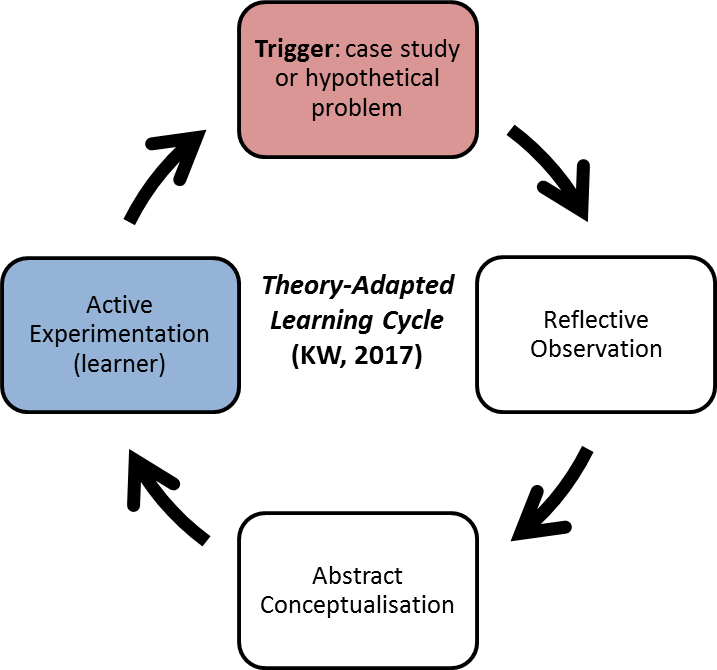
The Trigger-Adapted TSD
“Tell” could be applied in the creation of triggers. For example, a case study (the preferred method at Harvard Business School {Ellet, 2007}) could be used to establish context and present a problem. This would lead logically and intuitively into the theoretical content of the tutorial. Such an approach also incorporates meta-cognition, since it provides reasons for the existence of the theory and justifies the content of the teaching session.
“Show” could be verbal explanation, video, or printed diagrammatic material. Whatever form “Tell” assumes, this phase supplements or extends the information presented in the “Tell” phase. “Tell” and “Show” thus deliver the trigger.
Logically appropriate case study triggers are those that describe real companies facing real problems. Such case studies would lead students to deduce the solutions. If real case studies were unavailable (or excessively complex), a hypothetical anecdote would likely be adequate. Again, students would create a solution that solved a specific issue. That solution-creation effort thus becomes the “Do” phase. The two adapted stages thereby become compatible with TSD.
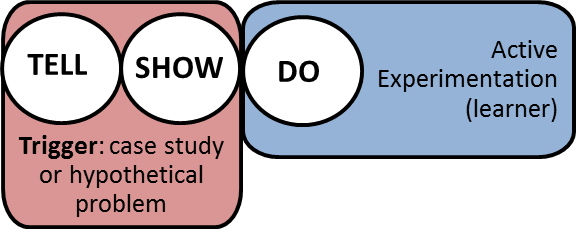
The TSD-Adapted Learning Cycle
Reflective Observation and Abstract Conceptualisation are post hoc events that occur outside the classroom, but will of course influence the planning of future in-class activity. However, the ELC when modified to reflect incorporation of the TSD method appears as follows:
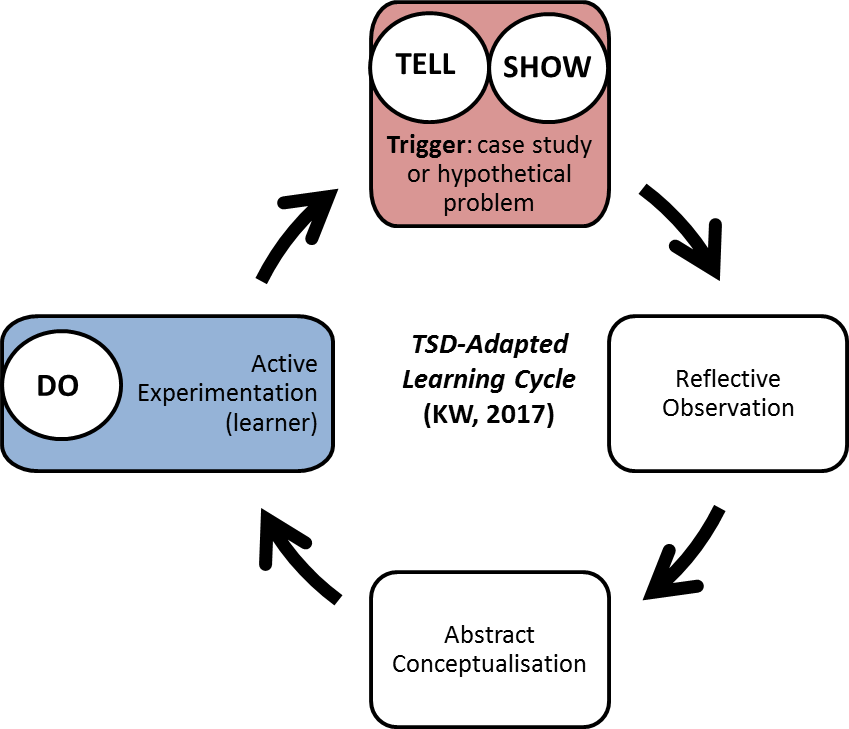
When reflecting on Kolb’s four stages, it occurred to me that the four stages could be used in the design of creative activities.
Kolb Applied to Creativity
Kolb’s four stages can be applied in the development of the creative tasks that occur in the “Do” or “Active Experimentation (learner)” phases.
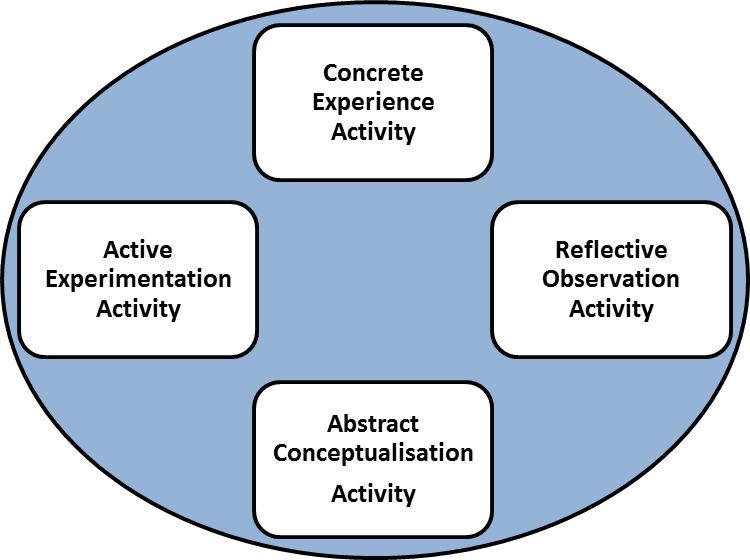
The following are examples of tutorial activities that I have designed to (a) be creative and thereby engage students in non-didactic, stimulating processes that deepen their learning of core concepts, and (b) to correspond with the four stages of Kolb’s cycle. The four do not flow in cyclic fashion. The teacher identifies which stage best represents the learners’ stage of learning and designs or selects an activity that corresponds with that stage.
Some of these activities could be performed by individual learners (these are indicated by [I]); others are more complex and/or time consuming so would be better performed by groups [G]. In many cases, the activity is suitable for both individuals and groups [I, G]. Because all the activities are designed for performance in tutorial periods, time is an ever-present constraint. However, time can be applied to some, perhaps all, of these tasks as a competitive element. Activities that could be improved by the application of time pressure are indicated by [T].
Creative Activities within Concrete Experience
These are relatively mechanical tasks that require little deep comprehension. They are suitable as early-stage, concept- and terminology-reinforcing activities. Most of these tasks demand recall more than creativity.
- Match terms to definitions exercise (draw lines on paper to connect terms to their corresponding definitions) [I, G, T]
- List the pros and cons of A, B, C. [I, G, T]
- List applications of the various forms of systems. [I, G, T]
- List the kinds of products/markets that would best be served by system A, B, C; state your reasons. [I, G, T]
Creative Activities within Reflective Observation
These tasks build on the understanding obtained in the preceding stage. These tasks require the learner to consider and propose modest applications, so demand a greater degree of creativity than the previous set of tasks.
- Find the most innovative example of A, B, C. Say why it is unique. [I,G]
- Design a production flow that has no crossing lines of material flows. [I, G]
- Sketch out a diagram that reveals systems within systems/layouts within layouts. [G]
- Sketch out a diagram that depicts the outbound and inbound flows of a car manufacturer. [G]
- Think of ten ways in which technology could be used to improve visibility or transparency. Use diagrams to explain your suggestions. [G]
- Identify the bottlenecks and points of vertical time accumulation in a supply chain design. [I, G, T]
Creative Activities within Abstract Conceptualisation
All three tasks in this stage require creative responses. What is being created in each task is secondary: of primary importance here is the evidencing of learning via creativity.
- Create a supply chain map to show the tasks performed and their relative locations; draw another SC map to show how the supply chain could be rationalised. [I,G]
- Group 1 argues in favour of the pull system; Group 2 argues in favour of the push system; both groups report the disadvantage of the other group’s system; both groups are encouraged to create as many non-verbal methods of demonstrating the advantages of their system/the disadvantages of the other system. [2G]
- Create a theoretical model that integrates operations issues with market requirements. [G]
Creative Activities within Active Experimentation
At this stage, the learners are required to create simulations that show applied understanding in the addressing of specific problems that are both theoretical and practical in nature. This is a purposefully narrowed development of the preceding stage.
- Using Lego, a large sheet of paper, and pens, create a Kanban system. [G]
- Using Lego, a large sheet of paper, and pens, demonstrate the relative efficiencies of competing systems. [G]
- Identify the common elements of theory A and B, and create a hypothetical scenario in which consideration of those elements could be useful. [I, G]
- Design a linear, accumulative manufacturing process using Lego as the product. [G]
Action Plan
Based on what I learnt from this workshop, I propose to implement elements of the following in future teaching.
- Apply “Tell, Show, Do, and Check”. “Show” and “Tell” occur at the trigger formulation and presentation stage (see preceding section on Triggers). “Do” is the student’s response to the task or problem that the teacher has shown or told. “Check” is my ongoing, mostly informal, ad hoc monitoring of and response to student performance of activities and any other indicators of comprehension.
- Apply metacognition though use of reflectively -paired learning outcomes and activities, and in bookending tutorials with “Tell” and “Check”, in which the purpose of the exercise is announced and the achievements of the session are summarised, respectively.
- Internalize the Learner’s Perspective. This enhances the efficacy of the “Check” element of “Show, Tell, Do, and Check”. It also reflects consideration of Rogers’ “empathy” (1977). The learner is monitored for cues of understanding, confusion, and emotional states. Teaching is adapted (slowed, quickened, expanded, or contracted) according to what is observed.
- Apply Kolb’s ELC in the planning of learning-facilitating tasks, i.e. the “Do” phase of the TSDC. Whenever the material permits, build tutorial sessions around creative tasks appropriate to the stage and content of the curriculum.
The Theory Developed: TSD and ELC Integrated
The following diagram illustrates how two originally disparate theories – TSD and ELC – have been integrated and to some degree harmonised by the identification of common elements that emerged during this report.
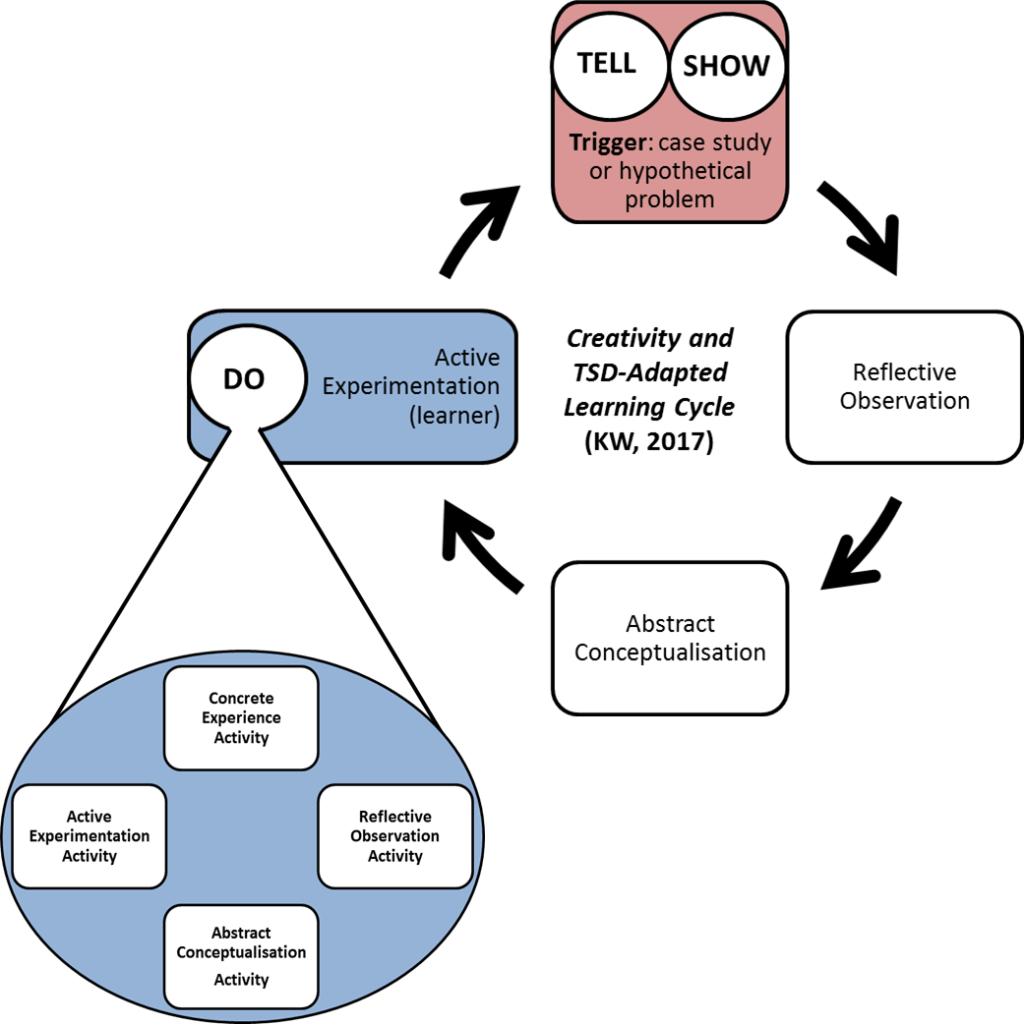
Originally, the Concrete Experience phase of Kolb’s classic cycle was changed to incorporate non-concrete experience, since in academic, andragogic contexts, direct, first-hand experience is rarely the starting point of learning. Instead of concrete experience, a likely learning-initiating trigger would be the posing of a problem or a situation. Hence, the first of Kolb’s phases became the trigger phase. In business studies, a typical trigger would be a case study of a real world problem that prompts learners to apply previous learning (“knowledge schema”, in Piaget’s terms) to predict outcomes and/or proffer solutions. The presentation of this trigger material can be likened to the “Tell” and “Show” phases of the TSD trinity. Ideally, the “Tell” would be accompanied by some informative, multi-sensory “Show” stimulus such as video. In the weakest scenario, a printed text would be briefly introduced and then distributed and read.
The two subsequent stages (Reflective Observation and Abstract Conceptualisation) vary in no meaningful way from the original definitions. These phases occur outside the teaching moment, during the teacher’s reflective practice.
The final stage, Active Experimentation, is relevant to both learner and teacher. For the learner, active experimentation involves the application and testing of knowledge via practical and/or creative tasks devised by the teacher. For the teacher, active experimentation involves the application of suitable practical and/or creative tasks based on a judgement regarding which of Kolb’s original four stages best represents the learners’ progress vis-à-vis the curriculum’s milestones or key learning points. Because these tasks are, whenever possible, practical and/or creative, this adapted phase of the ELC corresponds to the “Do” phase of the TSD trinity. The outcomes of these practical or creative tasks influence the material that is used as the next trigger. In this way, the cycle repeats.
*If the “Check” component of TSD+C were also to be incorporated, it would occur in the “Tell”, “Show”, and “Do” phases (phases 1 and 4 in the adapted ELC). In the “Tell” and “Show” phase, the teacher would be scanning the learners for indications of comprehension and adjusting the message on-the-fly. In the “Do” phase, the students’ task performance would be read as an indicator of effective learning. Assuming the success of the “Tell” and “Show” phase, most checking will occur in the “Do” phase, since students’ demonstration of comprehension will be evident by their performance. The checking that occurs at this stage will also provide the instructor with indicators of the optimum trigger of the next session.
